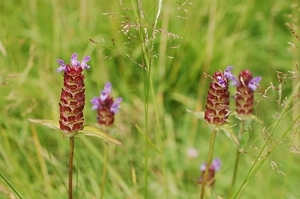Self heal
 If humans choose to name a plant self heal (Prunella vulgaris) it is a fair bet that it is for a good reason. This common little herb, which is found throughout Britain, does indeed have a long history of medicinal use. In fact, the 16th-century herbalist John Gerard said of the plant ‘there is not a better wounde herbe in the world’ and the 17th-century botanist Nicholas Culpeper wrote that the plant is called self heal because ‘when you are hurt, you may heal yourself’.
If humans choose to name a plant self heal (Prunella vulgaris) it is a fair bet that it is for a good reason. This common little herb, which is found throughout Britain, does indeed have a long history of medicinal use. In fact, the 16th-century herbalist John Gerard said of the plant ‘there is not a better wounde herbe in the world’ and the 17th-century botanist Nicholas Culpeper wrote that the plant is called self heal because ‘when you are hurt, you may heal yourself’.
Self heal is a perennial herb, a member of the mint family, and has a square stem which is often tinged with pink or crimson and can grow to around 10 inches in height, especially when in competition with long grass. It can also survive quite happily in a regularly mown lawn – I have lots in my own lawn! The bluish purple flowers can be seen from early June right through to the autumn.
The plant can spread itself through seeding; however it also produces underground creeping stems known as rhizomes, and so can slowly inveigle itself across an area of ground, throwing up stems to produce flowers. It has a rich source of nectar located at the bottom of the corolla tube, which is protected from tiny insects by a thick “wall” of hairs placed just above. The flower is especially adapted for fertilization by bees, who land on its lower part and thrust their proboscis down the tube – straight through the hairy defence! – to reach the nectar. During this process, the bees dust their heads with pollen and when they visit the next flower they smear this pollen onto the plant, thereby fertilizing it.
Medicinally, self heal was used for a range of purposes and was regarded as a highly effective treatment for all kinds of wounds and was also commonly used to staunch bleeding, both internally and externally. A liquid mixture of leaves was often used to treat sore throats and mouth ulcers, while a more solid paste was used externally for treating injuries such as sores and burns. A country name for the plant is carpenters herb due to its ability to stem bleeding and so was presumably encouraged to grow just outside the workshop!
We often dismiss these herbal remedies as old wives tales but research in China has revealed some interesting results, as studies found that self heal does indeed help to reduce blood pressure by gently widening the blood vessels, which in turn also reduces the heart rate. These studies also discovered that the plant possesses antibiotic properties that act against a wide range of pathogens.
So, should you want to try this pretty little herb out for yourself, an infusion made from 1OZ of leaves to one pint of boiling water – taken in doses of a wineglassful at a time – is considered to be a good all round general body tonic. When sweetened a little with honey and gargled, it is a very good remedy for a sore throat or ulcerated mouth and all of this for free, maybe even harvested from your own lawn!
Peter Thompson
Advisory
Read more from Peter Thompson at the Fresh from the Field blog.

Download Peter Thompson's essential 26-page book, featuring beautiful photography and detailed profiles of Britain's wildlife
Download FREE >